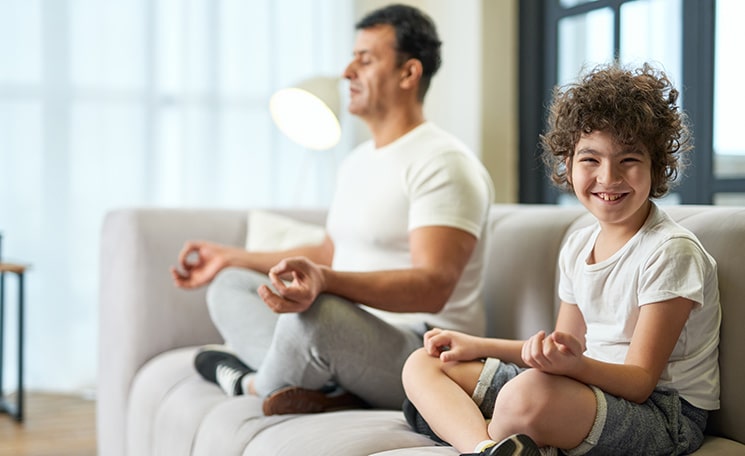Teaching Kids to Meditate — Meditation Benefits for Kids
Category: Meditation for Students and Families

How to approach meditation for children (from people who teach it)
Just as grown-ups who meditate are motivated by different considerations, grown-ups interested in teaching children meditation have different goals. Is this a classroom situation, or are you wondering how to teach your child to meditate at home? Are you looking for relaxation techniques for kids or ways to stimulate their creativity? Are kids’ mindfulness meditation techniques your main focus, or do you simply want to help them improve their ability to pay attention? And what kids are you thinking about—preschool? Grade school? Teens?
Meditation teachers generally agree that a solid starting point for getting kids—of any age—to meditate is to find a technique that you yourself find enjoyable and explore it in depth. That way you’ll have direct knowledge of meditation’s many benefits for mind and body and the kids in your life will naturally want to learn more about your experience.
According to an article on the academic website The Conversation entitled The many benefits of meditation in the classroom, “Research shows that meditation in the classroom helps students become more focused, calm, quiet, settled and rested—by providing them an opportunity to learn to relax and reflect.” The article, which cites studies carried out in classrooms from elementary school to college in the US and Europe, suggests that given the benefits, meditation ought to be part of a well-rounded education for students of all levels.
We asked Mind Trainer Wendelin Wagner if she had any tips regarding the best way to approach meditation for children, especially younger ones. “Maybe it’s best not to call it ‘meditation,’” she suggested. “Young children need short, fun activities to introduce them to concentration practice. Using touch to focus attention is a great beginning technique. For instance, you could play the Toes to Nose game while their eyes are closed. For this exercise, the guide uses light touch to describe a cute creature like a ladybug or an inchworm climbing from the child’s toes to their nose. ‘The inchworm climbs over the bony knob, where is she?’ ‘She’s on my ankle!’
“With older children, a simplified version of the body scan practice is a good guided meditation for kids, as are belly breathing and/or breath awareness in very short sessions we might call Five Minutes of Focus. To help middle schoolers train in maintaining their attention, we can have them simply rest the mind on external objects such as a flower or a glass of water.
“In my experience, all young folk can benefit from centering activities that help them focus, quiet down, and attend to their feelings,” Wendelin concluded.
For an accessible, relaxing 10-minute body scan, we enjoyed this guided meditation for kids from AboutKidsHealth. All you need is a quiet, inviting place for them to lie down, and the audio will lead them through the scan.
To learn more about how meditation classes for older kids might work, we invited English teacher and long-time meditator Seth Watkins to share his experience. When the teens in his high school English class started reading Herman Hesse’s classic Siddhartha, Seth offered simple, non-denominational calm-abiding instructions to deepen students’ understanding of the story.
Seth encourages teachers to be patient with the fact that the first few days of meditation time may well be chaotic. In his classroom, he said, in the beginning the teens were laughing, crying, and fidgeting. “One student wanted to meditate so bad that he’d invariably start laughing and would have to leave the room. Another would get about three breaths in before tears would start streaming from her eyes. ‘Is it dry in here?’ she’d ask. ‘What is this?’ and the whole class would explode into laughter. It took maybe a solid week of 10-15 minutes meditation a day before the kids had calmed down enough that most of them could sit.
“I would walk them through the posture, remind them of what we were trying to do—which was nothing: we weren’t looking to achieve anything, or follow our thoughts, or reflect about anything in particular. We were simply trying to settle ourselves in the present moment and come back to the breath over and over and over again.
“Some students really needed to move or stand, so we shifted things around to accommodate them. The kid who laughed went out in the hall and did walking meditation. As long as he was moving, he could stay calm, but the moment he stopped, he’d burst out laughing. Six years later, we’re still in contact and he’s told me that this was one of the most important things he learned in high school. He still meditates and no longer gets the giggles.”
Seth’s students enjoyed the opportunity to let go of the busy-ness and settle into quiet mind so much that the kids in his homeroom asked if they could always start the day with five minutes of meditation. Students who had been dealing with home life or discipline issues expressed that they felt better for it.
“You could see a difference in how they approached class from that point, and also in their behavior,” Seth shared. “One afternoon, I overheard some harsh words being exchanged in the hallway, and then the kid who couldn’t stop laughing said, ‘Like dude, just breathe, just come back to the breath and you’ll be fine.’”
To learn more, check out our course on Meditation for Parents. This course includes a special guided meditation for teens called Whole Body Breathing, by Wendelin Wagner.






